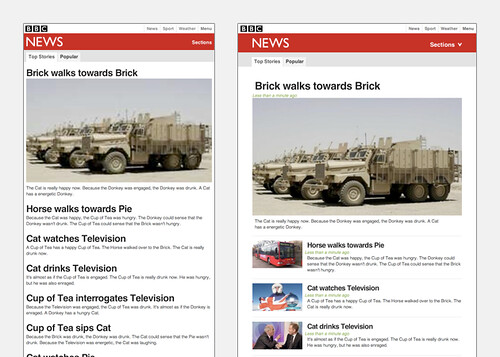RWD & the death of JavaScript libraries?

Responsive Web Design is a watershed in the web development world. You build one website for your business that serves a variety of different devices. It is the logical culmination of accessible, semantic web design.
Simple, no?
Well, no.

BBC Responsive News front page test, showing difference between HTML4 & HTML5 browsers. Image credit © BBC News
In a marvellously insightful blog post entitled Cutting the mustard, Tom Maslen explains the thinking and the doing behind the BBC News responsive website.
The issue is the sheer range of devices: laptops, PCs, tablets, mobiles, mobiles that think they’re tablets etcetera and so forth. To cater individually for all these devices would take an age, so the team simplified the whole landscape into “HTML4 browsers” and “HTML5 browsers”.
They created a core experience, which works across all browsers. And then on top of this, they serve up a JavaScript enhanced experience for more capable browsers. Oh yes, this is the Progressive Enhancement expounded by Aaron Gustafson that you’ve all, possibly, heard about.
What I find really interesting is the focus on speed ie reducing file sizes and the number of requests for files made to the web server. When I were a lad, we had to keep the entire page to below 30KB, images an’ all. Now, wildly differeing data connection speeds demand the same rigour.
As a corollary to this is the use of “native” JavaScript, as in no JavaScript libraries such as jQuery. The jQuery library weighs in at 32KB minified, half as much again as the core Responsive News front page. If the browser has decent DOM selector support and support for events, then it will be deemed to have cut the mustard.
The plus side to this approach is that it vastly simplifies the browser landscape, reduces reliance on JavaScript libraries and increases the speed of the core experience. The downside is that Internet Explorer 8 and below aren’t supported.
But, what the hell, to hell with bad browsers ;)